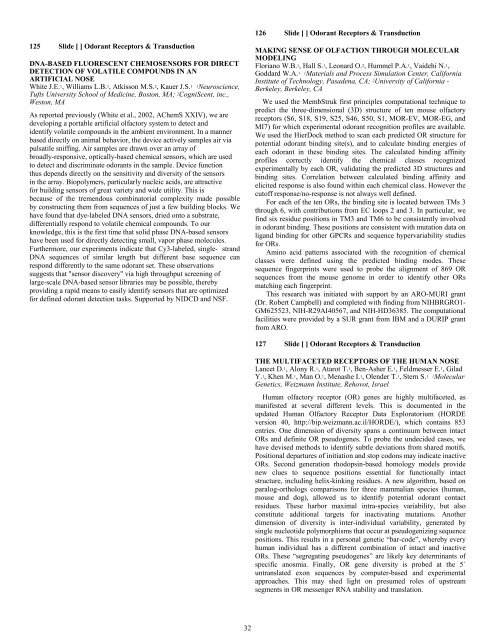Givaudan-Roure Lecture - Association for Chemoreception Sciences
Givaudan-Roure Lecture - Association for Chemoreception Sciences
Givaudan-Roure Lecture - Association for Chemoreception Sciences
You also want an ePaper? Increase the reach of your titles
YUMPU automatically turns print PDFs into web optimized ePapers that Google loves.
125 Slide [ ] Odorant Receptors & Transduction<br />
DNA-BASED FLUORESCENT CHEMOSENSORS FOR DIRECT<br />
DETECTION OF VOLATILE COMPOUNDS IN AN<br />
ARTIFICIAL NOSE<br />
White J.E. 1, Williams L.B. 1, Atkisson M.S. 2, Kauer J.S. 1 1Neuroscience,<br />
Tufts University School of Medicine, Boston, MA; 2CogniScent, inc.,<br />
Weston, MA<br />
As reported previously (White et al., 2002, AChemS XXIV), we are<br />
developing a portable artificial olfactory system to detect and<br />
identify volatile compounds in the ambient environment. In a manner<br />
based directly on animal behavior, the device actively samples air via<br />
pulsatile sniffing. Air samples are drawn over an array of<br />
broadly-responsive, optically-based chemical sensors, which are used<br />
to detect and discriminate odorants in the sample. Device function<br />
thus depends directly on the sensitivity and diversity of the sensors<br />
in the array. Biopolymers, particularly nucleic acids, are attractive<br />
<strong>for</strong> building sensors of great variety and wide utility. This is<br />
because of the tremendous combinatorial complexity made possible<br />
by constructing them from sequences of just a few building blocks. We<br />
have found that dye-labeled DNA sensors, dried onto a substrate,<br />
differentially respond to volatile chemical compounds. To our<br />
knowledge, this is the first time that solid phase DNA-based sensors<br />
have been used <strong>for</strong> directly detecting small, vapor phase molecules.<br />
Furthermore, our experiments indicate that Cy3-labeled, single- strand<br />
DNA sequences of similar length but different base sequence can<br />
respond differently to the same odorant set. These observations<br />
suggests that "sensor discovery" via high throughput screening of<br />
large-scale DNA-based sensor libraries may be possible, thereby<br />
providing a rapid means to easily identify sensors that are optimized<br />
<strong>for</strong> defined odorant detection tasks. Supported by NIDCD and NSF.<br />
32<br />
126 Slide [ ] Odorant Receptors & Transduction<br />
MAKING SENSE OF OLFACTION THROUGH MOLECULAR<br />
MODELING<br />
Floriano W.B. 1, Hall S. 1, Leonard O. 2, Hummel P.A. 1, Vaidehi N. 1,<br />
Goddard W.A. 1 1Materials and Process Simulation Center, Cali<strong>for</strong>nia<br />
Institute of Technology, Pasadena, CA; 2University of Cali<strong>for</strong>nia -<br />
Berkeley, Berkeley, CA<br />
We used the MembStruk first principles computational technique to<br />
predict the three-dimensional (3D) structure of ten mouse olfactory<br />
receptors (S6, S18, S19, S25, S46, S50, S1, MOR-EV, MOR-EG, and<br />
MI7) <strong>for</strong> which experimental odorant recognition profiles are available.<br />
We used the HierDock method to scan each predicted OR structure <strong>for</strong><br />
potential odorant binding site(s), and to calculate binding energies of<br />
each odorant in these binding sites. The calculated binding affinity<br />
profiles correctly identify the chemical classes recognized<br />
experimentally by each OR, validating the predicted 3D structures and<br />
binding sites. Correlation between calculated binding affinity and<br />
elicited response is also found within each chemical class. However the<br />
cutoff response/no-response is not always well defined.<br />
For each of the ten ORs, the binding site is located between TMs 3<br />
through 6, with contributions from EC loops 2 and 3. In particular, we<br />
find six residue positions in TM3 and TM6 to be consistently involved<br />
in odorant binding. These positions are consistent with mutation data on<br />
ligand binding <strong>for</strong> other GPCRs and sequence hypervariability studies<br />
<strong>for</strong> ORs.<br />
Amino acid patterns associated with the recognition of chemical<br />
classes were defined using the predicted binding modes. These<br />
sequence fingerprints were used to probe the alignment of 869 OR<br />
sequences from the mouse genome in order to identify other ORs<br />
matching each fingerprint.<br />
This research was initiated with support by an ARO-MURI grant<br />
(Dr. Robert Campbell) and completed with finding from NIHBRGRO1-<br />
GM625523, NIH-R29AI40567, and NIH-HD36385. The computational<br />
facilities were provided by a SUR grant from IBM and a DURIP grant<br />
from ARO.<br />
127 Slide [ ] Odorant Receptors & Transduction<br />
THE MULTIFACETED RECEPTORS OF THE HUMAN NOSE<br />
Lancet D. 1, Alony R. 1, Atarot T. 1, Ben-Asher E. 1, Feldmesser E. 1, Gilad<br />
Y. 1, Khen M. 1, Man O. 1, Menashe I. 1, Olender T. 1, Stern S. 1 1Molecular<br />
Genetics, Weizmann Institute, Rehovot, Israel<br />
Human olfactory receptor (OR) genes are highly multifaceted, as<br />
manifested at several different levels. This is documented in the<br />
updated Human Olfactory Receptor Data Exploratorium (HORDE<br />
version 40, http://bip.weizmann.ac.il/HORDE/), which contains 853<br />
entries. One dimension of diversity spans a continuum between intact<br />
ORs and definite OR pseudogenes. To probe the undecided cases, we<br />
have devised methods to identify subtle deviations from shared motifs.<br />
Positional departures of initiation and stop codons may indicate inactive<br />
ORs. Second generation rhodopsin-based homology models provide<br />
new clues to sequence positions essential <strong>for</strong> functionally intact<br />
structure, including helix-kinking residues. A new algorithm, based on<br />
paralog-orthologs comparisons <strong>for</strong> three mammalian species (human,<br />
mouse and dog), allowed us to identify potential odorant contact<br />
residues. These harbor maximal intra-species variability, but also<br />
constitute additional targets <strong>for</strong> inactivating mutations. Another<br />
dimension of diversity is inter-individual variability, generated by<br />
single nucleotide polymorphisms that occur at pseudogenizing sequence<br />
positions. This results in a personal genetic “bar-code”, whereby every<br />
human individual has a different combination of intact and inactive<br />
ORs. These “segregating pseudogenes” are likely key determinants of<br />
specific anosmia. Finally, OR gene diversity is probed at the 5´<br />
untranslated exon sequences by computer-based and experimental<br />
approaches. This may shed light on presumed roles of upstream<br />
segments in OR messenger RNA stability and translation.

















